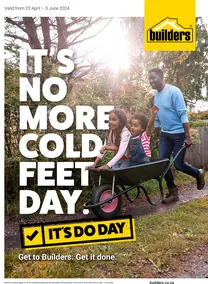
Builders SA shares gas safety tips to help consumers prepare for winter

With South Africa having experienced over a month of uninterrupted power supply, experts are cautioning about the potential re-introduction of power cuts as the colder months approach.
In light of this, Builders emphasizes the importance of preparing for winter by ensuring household gas safety.? Liquefied Petroleum Gas (LPG) is highlighted as an affordable solution for households to maintain essential functions such as powering stoves and geysers during power outages.?
While gas is a safe and reliable alternative to electricity, it requires responsible handling.
"As a licensed gas partner outlet that adheres to South African National Standards (SANS) regulations and is the only retailer that's an Afrox gas partner, we aim to provide essential information to South Africans about gas usage, safety and maintenance. This will enable families to use gas as a safe, efficient energy alternative during the colder months, keeping their homes warm and complying with national safety regulations. Builders also provide deliveries within a 30 km radius from the store."
?Here are some tips to help consumers safely set up gas in their homes:?
1. Installing Gas in Your Home: Ensure your gas installation complies with the SANS installation regulations guide. Some key points include: - Installing gas bottles at least one meter away from doors, windows, air vents, and ducting. - Sleeving all gas copper pipes passing through a wall for added protection. - Ensuring your gas installation has a certificate of conformity for gas appliances.
2. Connecting Gas to an Appliance: When connecting a gas cylinder to an appliance, ensure the connection is tight and there's no gas smell. Only licensed LPG installers or service companies should check and replace rubber or fibre washers.
3. Essential Safety Measures: Open the valve only 1½ turns. - Light the gas burner before opening the gas if the appliance lacks auto-ignition. - Place LPG cylinders on a firm surface. - Shut off the gas supply when not in use. - Ensure the valve is clean before connection.
4. Detecting Gas Leaks: Most gas leaks occur from defective rubber tubing, faulty regulator fittings, or improper handling of gas appliances. To detect a leak, rely on the "gas" smell, which is an odorant added to the mixture. Another method is applying soapy water to the valve area; bubbles will form at the point of the leak.
5. Knowing When Your Gas Cylinder is Empty: To check the gas level, pour hot water down one side of the bottle. A condensation line will appear, indicating the gas level inside. If the cylinder is empty, return it to your local Builders or exchange it safely online.
?"Gas cylinders are pressurized, so never attempt to refill an empty cylinder yourself. Return it to your local Builders or exchange it safely online to avoid potentially fatal accidents."?
Supplied by: Builders SA.
Guzzle Media
Get The Latest News & Specials
You successfully subscribed, thanks!
THIS WEEK'S TOP STORIES


Builders opens new store in Springfield KZN

New Vans Outlet Store Hits Boksburg With Unmissable Deals

You can now shop boohoo, boohooMan, and PrettyLittleThing on Superbalist





































































































































































































